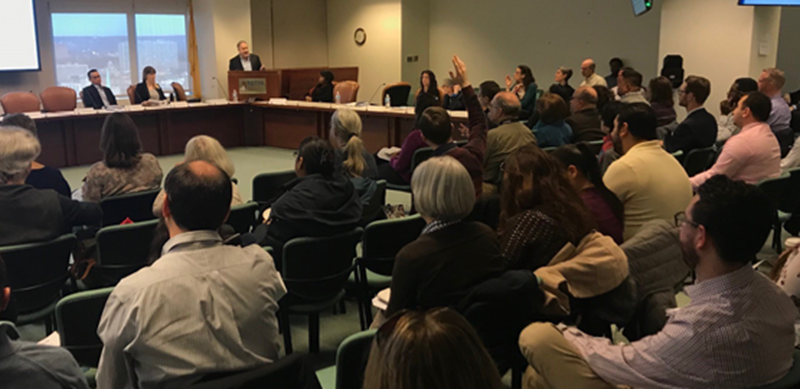February 2019
Posted: 2/11/2019 12:00:00 AM

A growing number of cities and towns are using “green infrastructure,” employing landscaping and natural materials, to replace or supplement “gray infrastructure,” composed of pipes and concrete, to manage stormwater and prevent flooding. It was the focus of February 6 Together North Jersey Training Institute workshop at the NJTPA.
With over 100 people in attendance, Bill Cesanek, Vice President, CDM Smith, gave an overview of the topic and introduced speakers who discussed how green infrastructure is being implemented in Philadelphia, New York City, Hoboken and Newark.
Green infrastructure “mimics the natural storm water cycle,” Cesanek said. Water running off from pavement and other impervious surfaces is slowed down or stored to allow it to gradually infiltrate back into the soil. Without this cycle, runoff can accumulate into damaging floods or overwhelm combined water and sewer systems, causing harmful outflows into streams or rivers.
Among the techniques used in green infrastructure are specially designed tree planters; landscaped medians, bumpouts or other areas along streets; permeable paving materials; rain gardens; green roofs on buildings; and subsurface storage systems. Among the benefits beyond reducing flooding, are supporting livability, natural habitats, public health and sustainable redevelopment.
He said New Jersey was “coming into its own” in encouraging the use of the systems, with new legislation in Trenton, new regulations by state agencies and innovations by many municipalities. NJ Future has a guide and toolkit on its website to assist these efforts, he noted.
Philadelphia is well along in its implementation of green infrastructure, said Elizabeth Svekla, Planning Manager of the Green Stormwater Infrastructure Unit in the city’s Water Department. A plan adopted eight years ago set a goal of creating 10,000 greened acres citywide in 25 years. The city, she said, has “hundreds of projects and thousands of acres” underway or in place.
She said that, especially in urban areas, each location must undergo detailed analysis and evaluation, noting that “micro-typologies” can affect waterflows and make them hard to predict.
New York City similarly is making great strides, said Vincent Lee, Associate Principal at Arup. The city in 2010 created a green infrastructure plan. It includes a goal of capturing rainfall from 10 percent of impervious surfaces in areas served by combined water-sewer systems.
He said in addition to borings and other investigations of suitable locations, communities have to be consulted in an effort to balance the infrastructure with other uses of space including parking, building access, subways and more.
In Hoboken, the city’s green infrastructure efforts gained new urgency in the aftermath of Superstorm Sandy, which inflicted heavy flooding and damage, said Jennifer Gonzalez, the city’s Director of Environmental Services and Chief Sustainability Officer. Seventy percent of the city is in the floodplain. Among the city’s responses are a Rebuild by Design program that includes plans for 61 rainwater storage systems to be installed as part of watermain replacements and rain water gardens in city parks.
In Newark, the city is taking creative approaches to fund and implement green infrastructure, said Robert Thomas, Chief of Energy and Environment in the City Department of Engineering. Along Ferry Street and other locations, funding for transportation projects such as signal replacements or pedestrian improvements, he said, are being leveraged to help implement green storm water improvements. He also emphasized the value of gaining support from partners including foundations and businesses. Recently, the City has partnered with the New Jersey Institute of Technologies as part of Smart City initiatives.
Presentations will be available on the Together North Jersey website. Full video of the event is available at https://youtu.be/X_zW8_nOBwA.